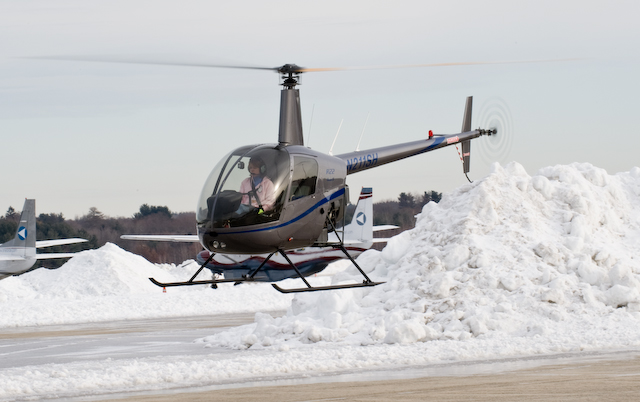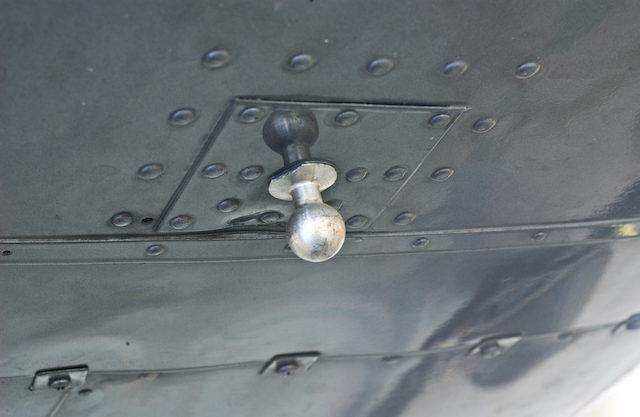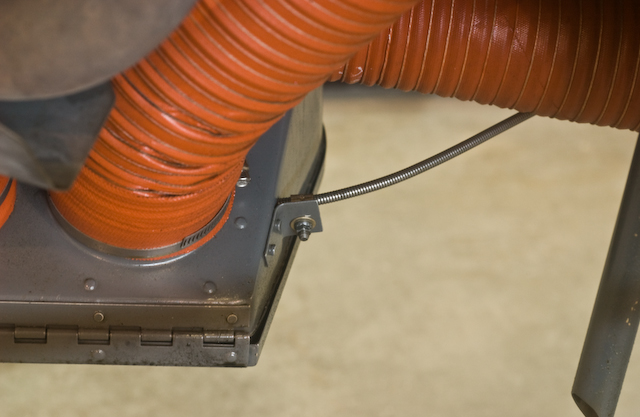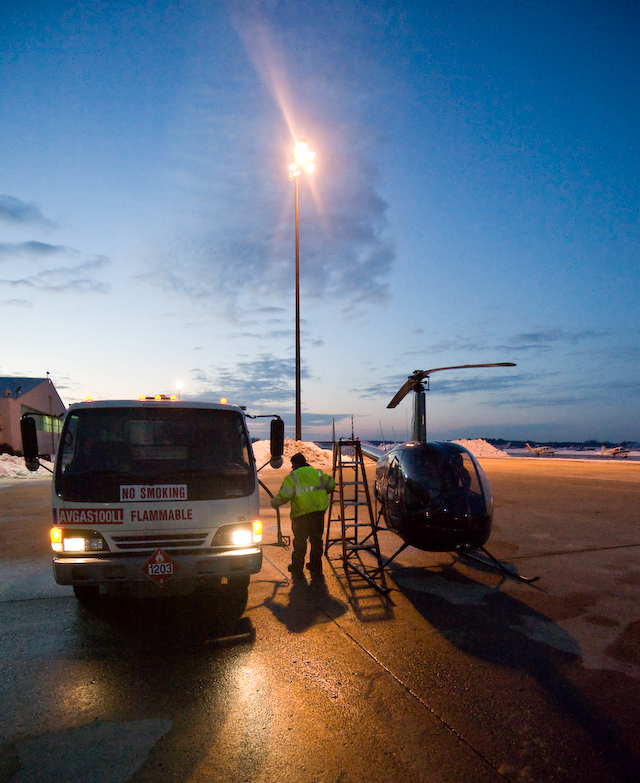Cowl_Door
Engine_Right_Side
Engine_Rear
Empennage
Tail_Rotor
Tailcone
Engine_Left_Side
Fuel_Tank
Main_Rotor
Fuselage_Left_Side
Nose_Section
Fuselage_Right_Side
Cabin_interior
Other_Stuff
R22 Preflight

Other Stuff You May Find Useful During Preflight
Make sure the control rods are attached and the pal nuts are all tight
 This is a picture of how the control rods attach to the swashplate.
This is a picture of how the control rods attach to the swashplate.
First of all, notice that you can see several control rods at the front of
the mast near the center right of the picture. To the left of the control
rods, just visible under the swashplate, you can see a piece of sheet
metal with a round hole cut in it. This allows maintenance personel to
mount track and balance equipment. Before Robinson included this part,
control rods would have to be disconnected /reconnected to mount the
equipment, and then disconnected and reconnected again to unmount the test
equipment. There have been several crashes in recent years where
maintenance failed to reconnect the control rods properly. If the aircraft
you fly does NOT have this mount and a track and balance has just been
performed, you should do an especially careful preflight to insure that
the control rods have been properly reconnected, the nuts are tight, and
the pal (jam) nuts are present.
What is the white hose in this picture?
 That's just a drain for the battery. The battery sits in a box which holds
it on the helicopter. The drain hose is in case the battery boils over, or
someone spills while filling it. The hose conducts acid away from the rest
of the helicopter.
That's just a drain for the battery. The battery sits in a box which holds
it on the helicopter. The drain hose is in case the battery boils over, or
someone spills while filling it. The hose conducts acid away from the rest
of the helicopter.
Does the Robinson have a blade droop stop?
 Yes, the Robinson head has 3 hinges: the center one is the teetering
hinge, the outer two are called "coning" hinges because they allow the
rotor system to cone. Keep in mind, though, that they work like the
flapping hinge on an articulated rotor system. If there wasn't a droop
stop, nothing would prevent the blade from dropping all the way to the
ground.
Yes, the Robinson head has 3 hinges: the center one is the teetering
hinge, the outer two are called "coning" hinges because they allow the
rotor system to cone. Keep in mind, though, that they work like the
flapping hinge on an articulated rotor system. If there wasn't a droop
stop, nothing would prevent the blade from dropping all the way to the
ground.
In this picture, you can see inside the head the part with the part number
A158-1 stamped on it. This is an extension of the rotor blade, which
extends way outside the hinge we see in the left side of the picture. The
blade is bolted to the hinge, and then there is a little curved extension
which is the A158-1 part we see in this picture. Because the hinge acts
like a fulcrum, when the outer portion of the blade goes up (cones up),
the little curved extension we see in this picture goes down. When the
blade comes all the way down, this little curved part goes all the way up
and hits the static stop which we see just below the pal nut with the
white stripe on it. So, it is this static stop which prevents the curved
part from going up, and therefore prevents the blade from coming all the
way down.
What is that puddle under the engine? Is it oil?
 Yes, it is engine oil, but this is one puddle you don't need to worry
about. The tube you see sticking down is the crankcase vent. This allows
the crankcase to breath. The oil is from oil vapor which has condensed
after shutdown and run down the tube and dropped onto the floor. It is
only a few drops of oil, and nothing to be worried about except for the
fact that it makes a mess on the hanger floor which you should clean up
before someone slips and falls!
Yes, it is engine oil, but this is one puddle you don't need to worry
about. The tube you see sticking down is the crankcase vent. This allows
the crankcase to breath. The oil is from oil vapor which has condensed
after shutdown and run down the tube and dropped onto the floor. It is
only a few drops of oil, and nothing to be worried about except for the
fact that it makes a mess on the hanger floor which you should clean up
before someone slips and falls!
What is a skid shoe and how do I check it?
 The skid shoe is made of a very hard material which protects the skid from
wear when sliding along on the ground, such as during running takeoff and
landings, touchdown autorotations, and surface taxi. You should check them
on preflight and make sure they have not worn all the way through. You can
do this with the landing gear on a flat level surface such as the floor of
a hanger by just looking from the side of the helicopter and making sure
that the skid is slightly above the floor (you'll see an air gap except
right where the skid shoe is.
The skid shoe is made of a very hard material which protects the skid from
wear when sliding along on the ground, such as during running takeoff and
landings, touchdown autorotations, and surface taxi. You should check them
on preflight and make sure they have not worn all the way through. You can
do this with the landing gear on a flat level surface such as the floor of
a hanger by just looking from the side of the helicopter and making sure
that the skid is slightly above the floor (you'll see an air gap except
right where the skid shoe is.
Before the skid shoe wears out, you can take it off and repair it - your
mechanic will know how. This will save you a lot of money compared to
ordering a new one from Robinson.
What is that shark fin shape under the helicopter?
 That is the antenna for the transponder.
That is the antenna for the transponder.
What is that ball underneath the belly?
 That is the lifting point you attach to if you use the Robinson helicopter moving machine.
That is the lifting point you attach to if you use the Robinson helicopter moving machine.
What is that cylindrical thing underneath the belly?
 That is the temperature probe.
That is the temperature probe.
What about the fittings in this picture on the engine side?
 That blue fitting is an oil line return hose. It is returning oil at low
pressure from the cylinder head to the oil sump. It is not under high
pressure the way the oil lines leading to and from the oil cooler are.
That blue fitting is an oil line return hose. It is returning oil at low
pressure from the cylinder head to the oil sump. It is not under high
pressure the way the oil lines leading to and from the oil cooler are.
What is this thing with the wire on the engine side?
 That is the lower spark plug. The upper spark plug is not visible until
you remove the engine sheet metal.
That is the lower spark plug. The upper spark plug is not visible until
you remove the engine sheet metal.
What is the wire in this picture going to the airbox?
 That is the carb heat control. When you pull up or push down on the carb heat, this cable slides a plate inside the airbox to select between cool and warm air.
That is the carb heat control. When you pull up or push down on the carb heat, this cable slides a plate inside the airbox to select between cool and warm air.
What kind of fuel can I put in the helicopter?
 Generally you use 100LL (100 low lead) [blue]. 100LL still has a huge
amount of lead in it, just not as much as the 100/130 fuel [green]. It's
been many years since I encountered 100/130 [green] aviation fuel. I doubt
anyone carries it anymore.
Generally you use 100LL (100 low lead) [blue]. 100LL still has a huge
amount of lead in it, just not as much as the 100/130 fuel [green]. It's
been many years since I encountered 100/130 [green] aviation fuel. I doubt
anyone carries it anymore.
You can't use the 80/87 [red] aviation fuel in the HP, Alpha, Beta, or
Beta II. The only version of the R22 that could burn that fuel was the
original "Standard" which only had 150HP engine. We had two Standards at
the flight school I learned at, but there probably are not any more of
those helicopters. Most of them got converted into HPs by adding a higher
compression head to the engine.
You can only run automotive fuel in the Robinson if you have an STC for
the aircraft. You buy the STC, and keep the paperwork in the aircraft.
That gives you the right to put automotive fuel in that particular
aircraft, but not in others. In other words, if you have 5 R22s, you would
have to buy 5 copies of the STC if you wanted to use autogas in all of
them.
[Top]
[Up]
[Prev]
[Next]













